Go chat yourself with Facebook’s new Portal companion app
Facebook has launched the start of its push into smart home software. Ignoring calls that it’s creepy, Facebook is forging onward with its Portal gadget Today Facebook quietly released iOS and Android Portal apps that let owners show off photos on the screen without sharing them to the social network, and video call their home while they’re out.

The app isn’t likely to move the needle for Portal whose potential users fall into two camps: those so alarmed by Facebook’s privacy practices that they couldn’t imagine putting its camera and microphone in their home, and those ambivalent or ignorant regarding the privacy backlash who see it as an Amazon Echo with a nice screen and easy way to video call family. Critics were mostly surprised by the device’s quality but too freaked out to recommend it. Those willing to buy it have given it a 4- to 4.4-star average rating on Amazon, praising its AI camera that keeps people in frame of a video chat while they move though jeering some setup difficulties.
Facebook announced at f8 a month ago that the Portal app was coming and eventually so would encrypted WhatsApp video calls. It also extended sales to Europe and Canada, though the new app is currently only available in the US according to Sensor Tower which tipped us off to the launch. The $199 10-inch Portal and $349 15.6-inch Portal+ launched in October, soured by a swirl of Facebook privacy scandals. Last week, the company tried to score some points with the public by funding an art project displayed at the SF Museum Of Modern Art. But the “immersive” exhibit was just some Portals stuck to some funky painted wooden backdrops, and it all felt smarmy and forced.
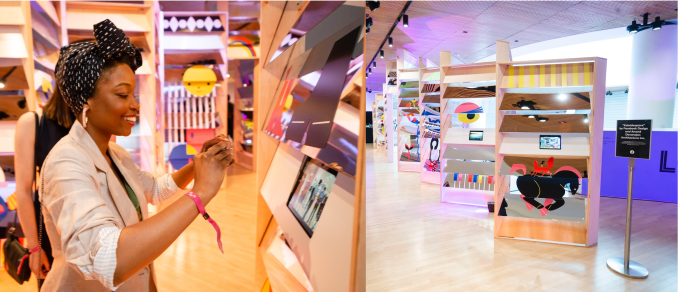
Facebook stuck Portals into wooden backdrops and called it art
Portal’s app lets you video call your Portal so you can say hi to family while you’re out. That’s great for traveling parents or seeing who is around the house in the post-land line age. The app also allows you to add and remove accounts on Portal and manage who’s in your speed dial Favorites, which you could already do from the device. There’s still no Amazon Prime Video or Smart home controls as were promised at F8.
The option to send photos directly from your camera roll to Portal’s Superframe fixes the worst feature of the digital photo frame. Previously you’d have to select just from photo/video albums you’d shared to Facebook. That meant you were only showing off sacchrine photos you were willing to post online, and if you selected Your Photos or Photos Of You, you might end up displaying shots that were embarrassing or that don’t make sense outside of the News Feed.

My workaround was to create a Facebook album of photos for Portal set to be visible only to me, but that was a hassle. Now you can manually grab pics and videos from your phone and send them to Portal without the worry they’ll show up on your profile. Portal also now can show off your Instagram photos, as was announced at F8. Still missing is Google Assistant support, which Facebook told me it was working to integrate last year.
Facebook’s steady improvements to Portal might not have shook its paranoia-inducing reputation amongst tech news readers and privacy enthusiasts, but they’ve kept it perhaps the best big screen and camera-equipped smart speaker. But in the seven months since launch, Google has copied Portal’s auto-framing camera for video chat in its new Nest Hub Max while Amazon is making a slew of home appliances smart. Portal will need more marquee innovations and some brand rehabilitation if it’s going to stay competitive.
[Postscript: The Portal app is also the foundation of Facebook’s foray into becoming a smart home competitor to Google/Nest, Amazon Echo, and Samsung SmartThings. Whether Facebook builds more gadgets or partners to make others’ more social, the Portal app is your remote control. It might not look like much today, but what starts small for Facebook often blossoms into giant strategic initiatives.]
Powered by WPeMatico
Pokémon GO will soon use sleep data to ‘reward good sleep habits’
Well, here’s a bit of surprise news this evening: At some point in the future, Pokémon GO is going to wrap the player’s sleep habits into the gameplay.
It’ll come as part of a wider initiative by The Pokémon Company to — as CEO Tsunekazu Ishihara put it in a press conference this evening — “turn sleep into entertainment.” Which… well, we’ll see how that goes.
Niantic CEO John Hanke took the stage at the press conference for a moment, but didn’t really offer much in the way of details. Said Hanke:
Niantic pioneered a new kind of gaming by turning the whole world into a gameboard, where we can all play and explore. By creating a new way to see the world and an incentive to go outside and exercise, we hoped to encourage a healthy lifestyle and to make a positive impact on our players and on the world. We’re delighted to be working with The Pokémon Company on their efforts to encourage another part of a healthy lifestyle: getting a good night’s rest.
At Niantic, we love exploring the world on foot. And that can’t happen unless we have the energy to embark on these adventures. We’re excited to find ways to reward good sleep habits in Pokémon GO as part of a healthy lifestyle. You’ll be hearing more from us on this in the future.
Ishihara also announced that The Pokémon Company is working with SELECT BUTTON (the company behind the 2017 mobile title Magikarp Jump) to make a separate game called Pokémon SLEEP. Next to no details on that one yet, though, besides a launch window of sometime in 2020 and the logo:

All of it will tap a just-announced device called Pokémon GO+ Plus (Yeah. Two plusses, one written. Go Plus Plus.) It’s a follow-up to the original GO+, which was built primarily to let you play Pokémon GO without actually looking at your phone’s screen. The GO Plus Plus will do everything the GO+ did (letting you tap a button to spin Pokéstops, or catch nearby Pokémon) but also has a built-in accelerometer allowing it to be laid on your bed to track sleep habits and send ’em back to your phone via Bluetooth.

And here’s a screenshot of a video that played alongside the announcement, showing the device as it’s meant to be used:

Powered by WPeMatico
FireEye snags security effectiveness testing startup Verodin for $250M
When FireEye reported its earnings last month, the outlook was a little light, so the security vendor decided to be proactive and make a big purchase. Today, the company announced it has acquired Verodin for $250 million. The deal closed today.
The startup had raised over $33 million since it opened its doors five years ago, according to Crunchbase data, and would appear to have given investors a decent return. With Verodin, FireEye gets a security validation vendor; that is, a company that can run a review against the existing security setup and find gaps in coverage.
That would seem to be a handy kind of tool to have in your security arsenal, and could possibly explain the price tag. Perhaps it could also help set FireEye apart from the broader market, or fill in a gap in its own platform.
FireEye CEO Kevin Mandia certainly sees the potential of his latest purchase. “Verodin gives us the ability to automate security effectiveness testing using the sophisticated attacks we spend hundreds of thousands of hours responding to, and provides a systematic, quantifiable, and continuous approach to security program validation,” he said in a statement.
Chris Key, Verodin co-founder and chief executive officer, sees the purchase through the standard acquisition lens. “By joining FireEye, Verodin extends its ability to help customers take a proactive approach to understanding and mitigating the unique risks, inefficiencies and vulnerabilities in their environments,” he said in a statement. In other words, as part of a bigger company, we’ll do more faster.
While FireEye plans to incorporate Verodin into its on-prem and managed services, it will continue to sell the solution as a standalone product, as well.
Powered by WPeMatico
Indie travel app Lambus makes group trip planning easier
There are plenty of travel apps for researching flights and hotels or generally organizing your trips, but indie German developer Hans Knöechel struggled to find one that could gather all his travel-related information in one place, in addition to allowing a group of friends to collaborate on the trip-planning process. So he built one for himself: Lambus, an app that lets you organize your travel documents, manage expenses, plus collaborate and chat with fellow co-travelers about the trip being planned.
Previously a senior software engineer at Appcelerator in San Jose, Knöechel came up with the idea for Lambus after being on the road a lot himself, and finding existing travel apps lacking.
“When traveling, you either use a manual folder with dozens of pages for all your information — or countless apps to display travel expenses, booking confirmations and waypoint planning. Alternatives like Google Trips, Sygic and Roadtrippers were always limited to one person and never offered all the features I needed during the trip,” he explains. “This gave me the idea for Lambus: A collaborative platform on which travel groups — in real-time — can display all the properties of the trip in an easy-to-use platform: Waypoints, travel expenses, booking documents, notes, photos and chat,” he says.
The resulting app he refers to as a “Swiss Army Knife” for travel planning.
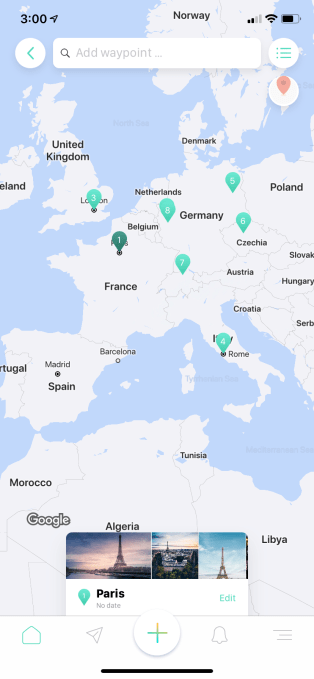
Like TripIt and others, travel documents can be shared with Lambus by forwarding emails to a unique personal email address. The imported documents — like plane tickets or Airbnb stays — will then be made available to all group attendees automatically. This is handy for group trips where often multiple people take turns making the various reservations, but don’t have any easy way to share the information with others beyond forwarding emails or writing down information in a shared online document.
Documents can also be uploaded through an “Import PDF” feature, as an alternative to email sharing. And photos can be added by snapping a picture or importing from the phone’s Camera Roll, as well.
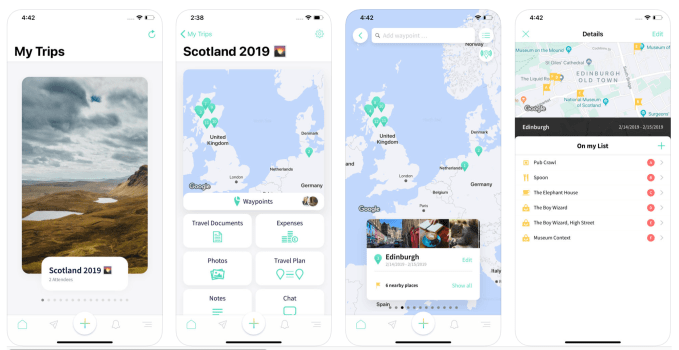
The photo feature is handy for saving those miscellaneous pieces of travel information — like how to access an Airbnb upon arrival, travel directions posted on an event or venue’s website, a helpful online review you saved and more. It’s also a fast way to import any other information, without having to rely on email or uploads.
In the expenses section, you can keep track of either private or group expenses by entering the amount and what it was for, and, optionally, if it’s been paid.
While largely aimed at group travel because of the collaboration and built-in chat features, the app can be used for solo trips, too.
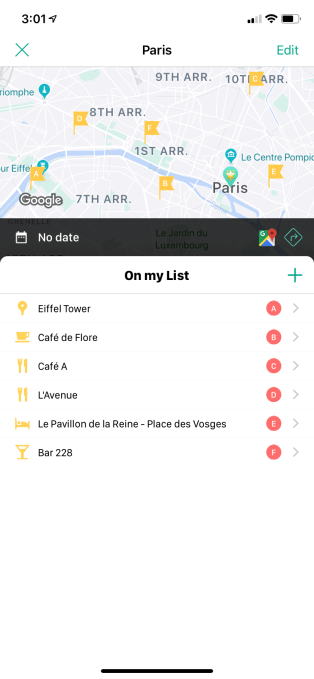
In testing the app, we found there were a few kinks that still needed to be corrected.
The calendar, for example, didn’t include the days of the week, only the dates — which was unusual. The app also had trouble finding some points of interest — like a convention center, for example, when it was entered directly in the search box. (It came up when we searched for a “nearby place” to an existing waypoint, oddly.) This appears to be a bug.
Some parts of the German app hadn’t been localized to English, either. For instance, when viewing the detail page for a waypoint, the “On My List” section read: “Noch keine Orte in der Nähe geplant.” (Meaning: “No places planned nearby.”)
More importantly, Lambus didn’t turn imported documents into an easy-to-read itinerary, as TripIt does. The travel plan, instead, included a list of waypoints but not the dates and times, with all the details like flight numbers or hotel reservation numbers. That’s perhaps a deal-breaker in terms of dumping all other travel apps in favor of Lambus alone.
Despite its quirks, the concept here is solid and the app is nicely designed with a bright and clean look-and-feel. The app is only a couple of months old, so given a little more time, attention and a few more releases, it has the potential to become a seriously useful travel tool for group trip planning.
The name, “Lambus,” is an odd choice, we have to also note.
Knöechel says he was searching for a word that was easy to pronounce in many different languages, and settled on this — a domain name he already owned.
While Knöechel is the sole founder, Lambus is a team of seven, including mainly university friends, he says. The startup is seed-funded by the Ministry of Economics in Germany (~€120,000), and eventually has plans to generate affiliate revenue by offering hotel, flight, Airbnb and activity bookings in-app.
Lambus is live on iOS and Google Play.
Powered by WPeMatico
Upsie nabs $5M to build a direct-to-consumer warranty service
Warranties for purchased products is a $40 billion annual market. But in their current form, they are considered by some to be one of the bigger scams in the world of retail because they cost so much and often return too little.
Now there is an alternative emerging. A startup out of Minneapolis, Minn. called Upsie has decided to wage war on the old warranty, with more reasonable pricing (typically 70% lower than what the retailer offers) and a much more modern approach to selling and managing the warranty.

Its bet is that lower prices, and more flexible options for ordering, tracking and claiming against warranties, will drive more users to its service and take some business away from the retailers that largely dominate the market today. Today it’s announcing that it has raised $5 million led by True Ventures to build out that business in the U.S. Techstars Ventures, Matchstick Ventures, Syndicate Fund, M25 and angel investor Marc Belton also participated.
If you’ve ever purchased an expensive consumer electronics product, you know the problem that Upsie is tackling: warranties can cost a lot, and in many cases you’re not sure what you might even be getting out of it. And if you do find yourself in the unfortunate predicament of needing to file a claim, you may find the process a little less than efficient, but hopefully not as bad as this:
“If you buy a product worth $900, a warranty might cost an extra $130, but that warranty might cost only $10 from the insurance company,” said Clarence Bethea, the CEO and founder of Upsie.
 When an expensive purchase like a consumer electronics product breaks down, the buyer needs to pay out big money for repairs or replacements, and that worry drives many of those customers to pay a big sum for the guarantee that someone else will cover those liabilities.
When an expensive purchase like a consumer electronics product breaks down, the buyer needs to pay out big money for repairs or replacements, and that worry drives many of those customers to pay a big sum for the guarantee that someone else will cover those liabilities.
The operative words in that last paragraph are “big sum”: a warranty can represent peace of mind, and sometimes actually help in those cases where something relatively new does break down, but one of the big issues is the mark-up that providers put on a service that preys on the fear of needing it — in some cases a warranty can cost as much as 900% more than the policy would cost if it were purchased directly from an insurance provider.
Bethea used to be a consultant to big-box retailers and in the work he did, he realised quickly that the retailers were taking advantage of consumers when they were selling warranties on top of products. “Consumers don’t know what the warranties actually cost,” he said. “That’s what pushed me into this.”
Upsie gives consumers the option to purchase warranties up to 60 days after the sale (or 45 for smartphones). The product itself needs a minimum 90-day warranty from the manufacturers themselves, and the Upsie warranty does not kick in until 30 days after it’s purchased — the idea being that it picks up right after the manufacturer warranty ends.
The warranties can be purchased online or through an app and they apply currently to around 15 categories and hundreds of electric goods covering areas like computers, wearables, phones, TVs, small and large appliances and outdoor tools. The Upsie app in itself is like your warranty file in your filing cabinet, except much simpler and lighter and less cluttered: it stores receipts, lets you scan SKUs to register the goods and more to make it easier. Then after a user purchases the warranty, it can be managed and claims can be filed by way of Upsie’s app.
The basic idea behind Upsie is reminiscent of the direct-to-consumer brands that have grown in popularity over the last several years.
Just as these have leveraged the web, mobile apps and more recently social media to build direct relationships with consumers, Upsie is also bypassing retailers and hoping that consumers will consider their cheaper alternatives, which in actuality have been negotiated with the same warranty service providers that the retailers use. It currently works with Centricity, and the plan is to expand it to a wider range over time.
Other companies have built businesses in the area of providing warranty services outside of what retailers offer, such as SquareTrade, which was acquired by AllState, and Asurion. Puneet Agarwal, a partner at True Ventures, believes that it stands out.
“Upsie is the only consumer-facing brand in the space, whereas everyone else is more of a back-end provider,” he said. “Their subscriber growth and engagement are tremendous and the end consumer identifies with them. Because of their direct consumer focus, they also offer a level of pricing, convenience and customer service the industry has not seen.” He added that the “big ambition” is “to make the idea of ‘upsie-ing’ a product as part of the the everyday lexicon of the consumer.”
Bethea said that one of the big early challenges was convincing insurance companies that D2C was a viable idea — which dissipated as insurance companies, like all brands and B2B2C businesses, began to consider the plethora of ways that people are buying goods today, which increasingly extend well outside the realm of just retailers.
The other challenge that is still one that Upsie will continue to work to surmount as it continues growing is convincing consumers to change their behavior. “Initially it was about convincing the industry that this is a market,” he said. “Today it’s awareness and giving consumers another option. ‘I didn’t know I could leave the register and purchase a plan afterwards’ is what we want people to be thinking.”
So far, the results have been pretty positive. Since exiting beta in 2016, Bethea said the company has grown 300% each year. Services are live only in the U.S., and while it works toward expanding to international markets, it will also be adding auto warranties to its plans next.
Living outside of Silicon Valley as I do, companies that are outliers from the normal pattern that often list the same litany of credentials (including but not limited to grads from Stanford or MIT, possible stint at YC, office in San Francisco, past history at other tech companies), but are still thriving, do tend to catch my eye. Upsie, with its roots in the Midwest and an African American founder (also not very common at the typical SV startup), and tackling something that is fundamentally broken but not flashy, ticks some of those boxes.
Turns out that True sees and wants to seek out more of this, too.
“Great companies are being built everywhere,” said Agarwal. “More and more of the companies we invest in are outside of the Valley or are building teams outside of the Valley and we encourage it. It can be a tremendous competitive advantage both from a talent and cost perspective. We have had great success investing in places like Michigan, Montana, Oregon, Wisconsin, Washington, even recently in Africa, and now in Minnesota with Upsie. I still do see a lot of bias from investors not wanting to invest outside of the Valley. There is no question they will miss out not because of high prices in the Valley but because of the opportunity.”
Powered by WPeMatico
The Looking Glass Pro might be the weirdest all-in-one PC ever
All-in-one PCs have adopted some pretty odd designs over the years, but I’ve never seen one quite like this.
The Looking Glass Pro is an all-in-one gaming PC that’s focused on one thing, visualizing 3D content on its bizarre lenticular display that makes you feel like you’re staring into a glass box filled with pixels. The embedded 4K display renders dozens of potential views and pipes them out as lower-res slices through some bizarre lens wizardry so that users can see the onscreen content in volumetric 60fps 3D without needing glasses.
You can get a better sense of how exactly this looks from a video that the company tweeted out.
With #AWE2019 fast approaching, a couple of exciting announcements coming your way! Numero 1⃣: Today, we launched the Looking Glass Pro, an all-in-one solution designed specifically for businesses seeking a turnkey holographic display solution https://t.co/IkKe6cFicf pic.twitter.com/0kGGoVxHzp
— Looking Glass Factory
#AWE2019 Booth 705 (@LKGGlass) May 28, 2019
This isn’t the first product from Brooklyn-based Looking Glass Factory, but it is a culmination of all their weirder efforts to date.
Last year, the company raised nearly $850,000 in a crowdfunding campaign for its Looking Glass display, focusing the market for the display technology on creators looking to visualize 3D graphics and objects without having to toss on a VR headset. The company has disclosed nearly $14 million in funding.
With the new hardware, the startup is aiming to court some enterprise customers to shove one of these front-and-center on their conference table displays, hoping that the new design can streamline the process of showcasing 3D content. Looking Glass Factory is courting everyone who has ever brought a VR headset to showcase 3D content. The startup argues that their solution showcases glorious 3D but doesn’t require a headset, and can showcase multiple views to multiple people at once.

Copyright 2006 Phoebe Cheong, all rights reserved
The hardware is focused on ensuring that you can cue up content and live-render it as users manipulate the content or change views with the on-board touch controls. The Looking Glass Pro integrates an Intel NUC 8 VR mini PC running Windows as well as a 7″ secondary touch panel screen that flips out from the side to make navigating the PC a bit easier, though that process still seems to be a tad janky at the moment.
The whole premise for this thing is weird and cool but also super expensive. The original 15.6″ Looking Glass display was $3,000; this thing is $6,000. The workstation is available for pre-order now and ships in July.
Powered by WPeMatico
VCs give failed AR startup Meta a do-over with new CEO, corporate entity
AR startup Meta’s original investors might have been screwed by the company’s collapse and fire sale, but a pair of VC firms are giving the brand another shot with a new corporate entity and CEO that the new backers hope will lead to a less abysmal outcome.
Meta Company is now Meta View, “a wholly new and unaffiliated entity.”
Meta v1’s not-so-differentiated approach to the AR market led it into trouble competing with teams from Magic Leap and Microsoft that were more focused on new technologies, though Meta was also well-financed with some $73 million in funding raised, according to Crunchbase. The issue came as the company burned through that cash with the expectation that more was on the way. The unexpected dissolution of a $20 million funding round sunk the company and left it scrambling.
Ultimately, the company’s assets were sold months ago — for “less than the bank was owed” — to a mystery buyer that we now know was Olive Tree Ventures .
This isn’t the most conventional investment for Israel-based Olive Tree Ventures. One would imagine a deal like this comes from a specialized investor who finds dead startups, puts a new coat of paint on their IP and attempts to revive old relationships, but Olive Tree is just an early-stage VC firm. The fund generally focuses its investments on Israeli startups, though Meta View will be based in San Mateo, and has traditionally invested in healthtech, something the AR startup was not particularly focused on in its former life.
“We remain extremely bullish on the potential for spatial computing. Our belief was so strong that we did a somewhat non-traditional VC deal to acquire the assets, start a new company and find a new CEO with a vision and focus we believed in,” said Olive Tree Ventures GP Mayer Gniwisch in a statement.
The new company is also launching with an undisclosed amount of funding from Montreal-based BNSG Capital .
It’s not entirely clear what the worth is in so fully reviving the Meta brand, other than scrounging up some faith in the Meta 2 headsets, on which the company staked its reputation. The company will not be selling the Meta 2, but will be supporting previously sold headsets as it works on new hardware.
While this whole situation feels a tad dodgy, the new company’s CEO Jay Wright lends the new venture some credibility. Wright was a co-founder of Vuforia, which really helped blaze a lot of trails in the AR space, and he has led the product at PTC since it was acquired in 2015. Not mentioned in any communications from the new company is the name of Meta’s founding CEO Meron Gribetz, whose role, if any, with Meta View is unclear.
Powered by WPeMatico
Leaked screenshots confirm dark mode is coming to iOS 13
9to5Mac’s Guilherme Rambo managed to obtain screenshots of iOS 13. While it still looks like iOS, there’s a twist — there will be a system-wide dark mode to make your apps look better at night. Apple is expected to announce the new version of iOS at its WWDC keynote on Monday.
With iOS 13, users can enable dark mode in the Settings app or with a toggle in Control Center — you may have to add the Control Center button in the Settings app first.
And here’s what it’ll look like according to 9to5Mac’s screenshots:
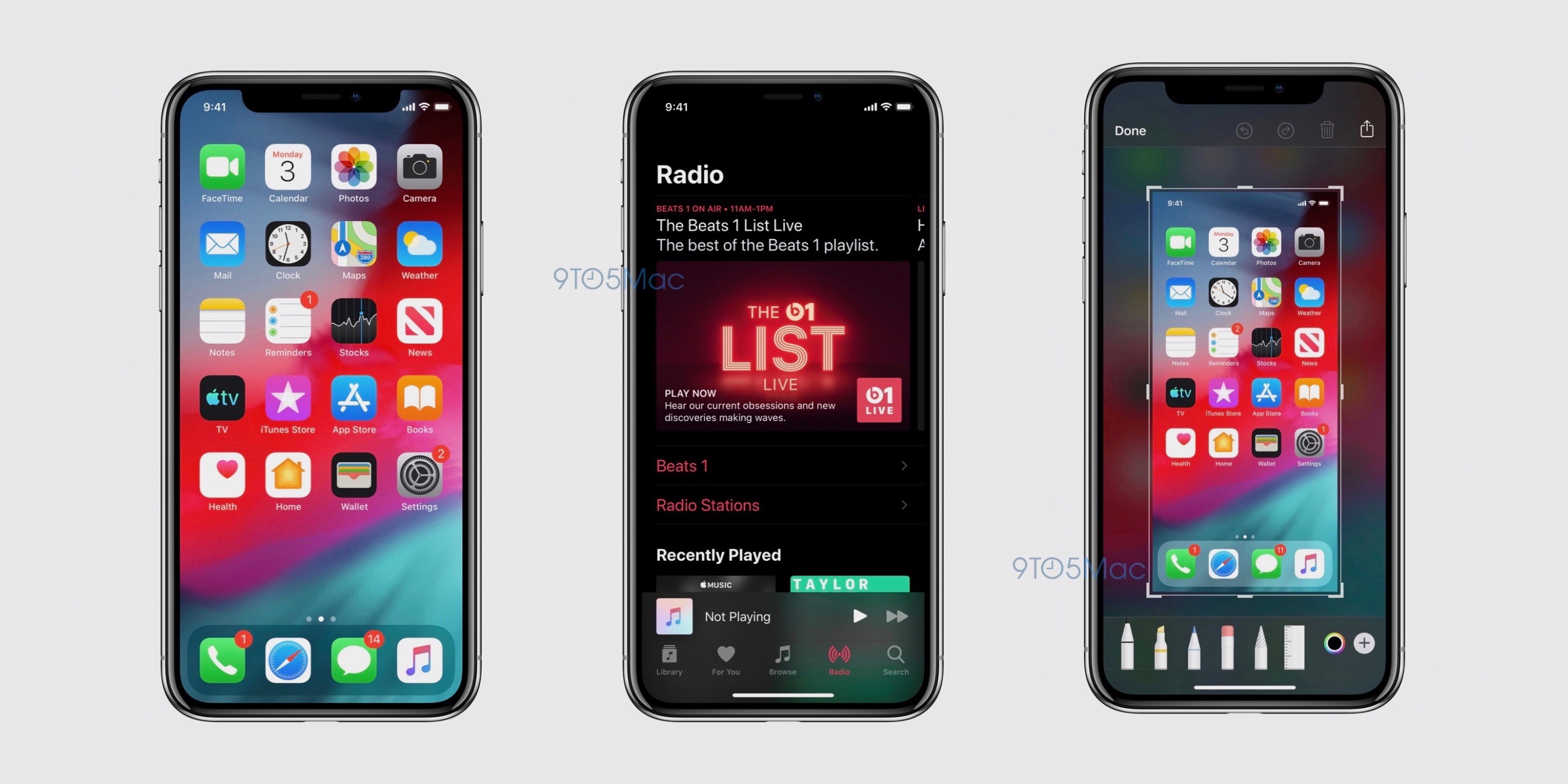
As you can see, the home screen doesn’t change much, except the dock at the bottom. But the Music app looks completely different with white text on top of a black background. The tab bar at the bottom also switches from transparent white to transparent black. Apple still uses red for buttons and links, which makes the app slightly less readable.
Enabling dark mode also affects user interface elements at the operating system level. When you take a screenshot and tap on the screenshot thumbnail, top and bottom menus are dark, for instance. Developers should be able to support dark mode in third-party apps as well.
In other news, Rambo also shared a screenshot of the new version of the Reminders app. It now features four different menus — today, scheduled, all and flagged. The user interface has been refreshed as well.
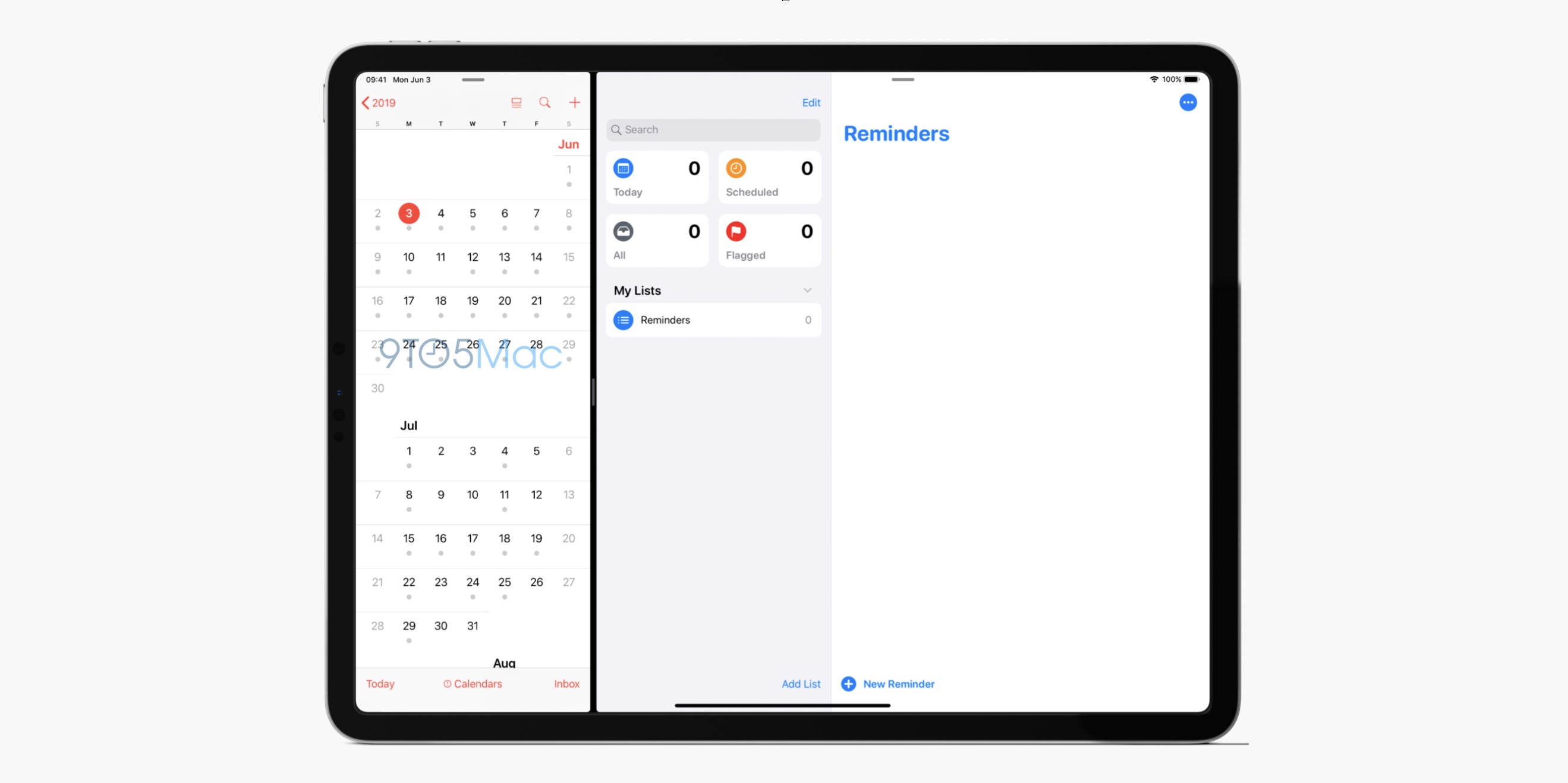
Finally, 9to5Mac also confirms a previous scoop with the icon of a new app called “Find My.” Apple plans to merge Find My Friends and Find My iPhone into a single app on both the iPhone and iPad.
Rumor has it that there will be more fundamental changes with iOS 13. Apple plans to let you open multiple windows of the same app. This way, users will be able to work on multiple documents or see multiple conversations at the same time. This will be a key new feature for iPad users in particular.
You can also expect smaller updates to Safari, Mail, font management, the volume indicator, the keyboard, etc.
Powered by WPeMatico
The challenges of truly embracing cloud native
There is a tendency at any conference to get lost in the message. Spending several days immersed in any subject tends to do that. The purpose of such gatherings is, after all, to sell the company or technologies being featured.
Against the beautiful backdrop of the city of Barcelona last week, we got the full cloud native message at KubeCon and CloudNativeCon. The Cloud Native Computing Foundation (CNCF), which houses Kubernetes and related cloud native projects, had certainly honed the message along with the community who came to celebrate its five-year anniversary. The large crowds that wandered the long hallways of the Fira Gran Via conference center proved it was getting through, at least to a specific group.
Cloud native computing involves a combination of software containerization along with Kubernetes and a growing set of adjacent technologies to manage and understand those containers. It also involves the idea of breaking down applications into discrete parts known as microservices, which in turn leads to a continuous delivery model, where developers can create and deliver software more quickly and efficiently. At the center of all this is the notion of writing code once and being able to deliver it on any public cloud, or even on-prem. These approaches were front and center last week.
At five years old, many developers have embraced these concepts, but cloud native projects have reached a size and scale where they need to move beyond the early adopters and true believers and make their way deep into the enterprise. It turns out that it might be a bit harder for larger companies with hardened systems to make wholesale changes in the way they develop applications, just as it is difficult for large organizations to take on any type of substantive change.
Putting up stop signs
Powered by WPeMatico
IBM-Maersk blockchain shipping consortium expands to include other major shipping companies
Last year IBM and Danish shipping conglomerate Maersk announced the limited availability of a blockchain-based shipping tool called TradeLens. Today, the two partners announced that a couple of other major shippers have come on board.
The partners announced that CMA CGM and MSC Mediterranean Shipping Company have joined TradeLens. When you include these companies together with Maersk, the TradeLens consortium now encompasses almost half of the world’s cargo container shipments, according to data supplied by IBM .
That’s important, because shipping has traditionally been a paper-intensive and largely manual process. It’s still challenging to track where a container might be in the world and which government agency might be holding it up. When it comes to auditing, it can take weeks of intensive effort to gather the paperwork generated throughout a journey from factory or field to market. Suffice to say, cargo touches a lot of hands along the way.
It’s been clear for years that shipping could benefit from digitization, but to this point, previous attempts like EDI have not been terribly successful. The hope is that by using blockchain to solve the problem, all the participants can easily follow the flow of shipments along the chain and trust that the immutable record has not been altered at any point.
As Marie Wieck, general manager for IBM Blockchain told TechCrunch at the time of last year’s announcement, the blockchain brings some key benefits to the shipping workflow:
The blockchain provides a couple of obvious advantages over previous methods. For starters, [Wieck said] it’s safer because data is distributed, making it much more secure with digital encryption built in. The greatest advantage though is the visibility it provides. Every participant can check any aspect of the flow in real time, or an auditor or other authority can easily track the entire process from start to finish by clicking on a block in the blockchain instead of requesting data from each entity manually.
The TradeLens partners certainly see the benefits of digitizing the process. “We believe that TradeLens, with its commitment to open standards and open governance, is a key platform to help usher in this digital transformation,” Rajesh Krishnamurthy, executive vice president for IT & Transformations at CMA CGM Group, said in a statement.
Today’s announcement is a big step toward gaining more adoption for this approach. While there are many companies working on supply chain products on the blockchain, the more shipping companies and adjacent entities like customs agencies who join TradeLens, the more effective it’s going to be.
Powered by WPeMatico

